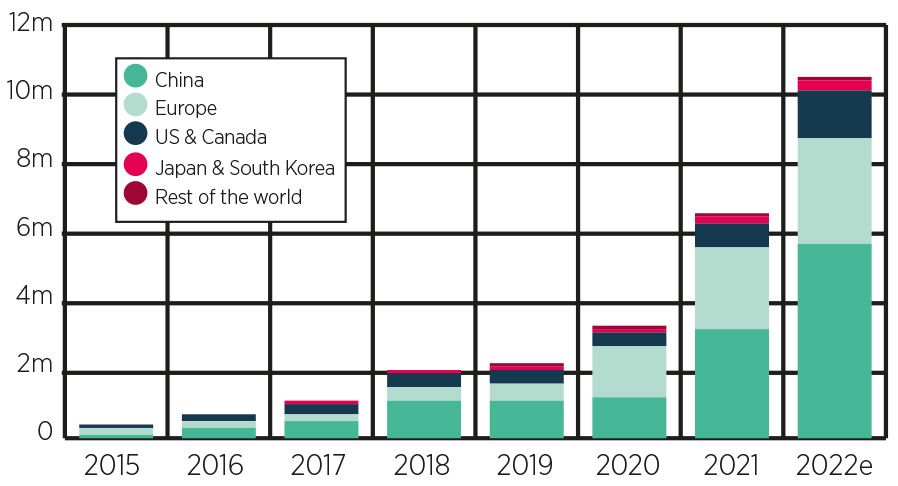Demand for electric vehicles (EVs) is set to soar, and the development of a charging ecosystem to support the new fleet of EVs on the road could be the next big ESG investment opportunity, according to Frédérique Carrier (pictured), head of investment strategy for the British Isles and Asia at RBC Wealth Management.
There are a few important factors underpinning an explosion in demand for EVs, she said. These include national targets to phase out internal combustion engine cars, as well as the falling cost of EV ownership and better consumer perception of these cars.
Consumers bought 6.5 million EVs last year – twice as many as in 2020 – and BloombergNEF predicts the total will grow by more than 60% this year to 10.6 million.
Demand for electric vehicles soars

China and Europe are the largest markets, though the US should soon join these leaders, said Carrier.
EV use will be key to solving the climate emergency, given that transport accounts for close to a quarter of global carbon emissions, with road vehicles generating about 75% of that.
Falling ownership costs
Boston Consulting Group calculated that five-year total ownership costs for electric vehicles, including maintenance, miles and electricity costs as well as the purchase price, should fall to become on par with internal combustion engine cars by the end of the decade, Carrier noted.
Battery costs account for as much as 40% of the price of an EV, and these are falling rapidly due to greater economies of scale as production ramps up, so this should help support growth in EV sales, she argued.
EV drivers suffer ‘charging anxiety’
As adoption of electric vehicles increases, it will be vital for the installation of public chargers to continue at pace if manufacturers are to stay ahead of demand.
Carrier explained that ‘range anxiety’ – the fear that an EV’s batteries will run out of power before a driver reaches a destination, has diminished in recent years as software and batteries have improved. However, range anxiety has been replaced by ‘charging anxiety’.
“EV drivers now fear running out of power at an inopportune time and being stranded due to an inability to easily, quickly, and efficiently recharge their cars while travelling. One survey highlighted the lack of public charging sites as the leading reason US consumers hesitate to buy an EV,” said Carrier.
“Solving charging anxiety is crucial to reducing hesitancy around electric cars and accelerating their adoption.”
What could hamper growth?
Although there are many positive signals for growth in the EV market, there are two main headwinds that could stop them reaching their full potential, Carrier argued. These are supply chain issues and charging infrastructure.
Supply chain disruption during the pandemic, and worsened by the war in Ukraine, has reduced supply of EV components such as the lithium and nickel used in batteries. RBC Wealth Management expects EV makers to find new sources of production to deal with these problems.
The charging challenge
There are currently 1.8 million public chargers for electric vehicles worldwide. Most EVs in the US are charged at home or at work using private charging points because of the availability of off-street parking where charging points can be installed, but in Europe and China, 70% and 60% of charging respectively happens at public charge points.
China has one charging point per five EVs compared to one per seven EVs in Europe and one per 20 in the US.
Globally, the number of public chargers will have to expand by eight times to reach over 15 million units in 2030 to give consumers adequate coverage, Carrier said, pointing to data from the International Energy Agency.
This presents a huge opportunity for investors. But it will not be easy – the power grid itself will need to be expanded to deal with higher electricity demand.
Which companies are involved?
Companies that are actively participating in this theme include California EV infrastructure company ChargePoint, EV makers Tesla and General Motors, and car manufacturers BMW, Mercedes-Benz, VW, Ford and Hyundai which are partnering to create an ultra-fast charging network.
“Finally, some energy companies are acquirers, such as Shell who bought Ubitricity, one of the UK’s largest public EV charging networks with plans for both curbside and fast charging connectors. BP and Total have also been scooping up EV charging companies, as have utilities firms,” Carrier explained.
‘Great promise’
“The anticipated growth in the EV charging ecosystem holds great promise for companies throughout the value chain, though as the market is still in its infancy, much change will take place over the coming years.
“Electric cars and the development of the related charging infrastructure are among the most vibrant spaces within the clean energy theme thanks to the commitments of governments and manufacturers.
“Much of the discussion today around the obstacles to EVs fulfilling their promise has centred on the shortage of raw materials for batteries. Yet a well-functioning, reliable charging network that can build public confidence is no less important,” she added.








